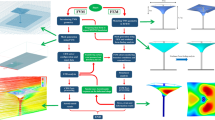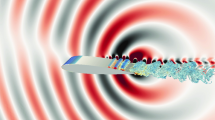Abstract
The present paper highlights results derived from the application of a high-fidelity simulation technique to the analysis of low-Reynolds-number transitional flows over moving and flexible canonical configurations motivated by small natural and man-made flyers. This effort addresses three separate fluid dynamic phenomena relevant to small fliers, including: laminar separation and transition over a stationary airfoil, transition effects on the dynamic stall vortex generated by a plunging airfoil, and the effect of flexibility on the flow structure above a membrane airfoil. The specific cases were also selected to permit comparison with available experimental measurements. First, the process of transition on a stationary SD7003 airfoil section over a range of Reynolds numbers and angles of attack is considered. Prior to stall, the flow exhibits a separated shear layer which rolls up into spanwise vortices. These vortices subsequently undergo spanwise instabilities, and ultimately breakdown into fine-scale turbulent structures as the boundary layer reattaches to the airfoil surface. In a time-averaged sense, the flow displays a closed laminar separation bubble which moves upstream and contracts in size with increasing angle of attack for a fixed Reynolds number. For a fixed angle of attack, as the Reynolds number decreases, the laminar separation bubble grows in vertical extent producing a significant increase in drag. For the lowest Reynolds number considered (Re c = 104), transition does not occur over the airfoil at moderate angles of attack prior to stall. Next, the impact of a prescribed high-frequency small-amplitude plunging motion on the transitional flow over the SD7003 airfoil is investigated. The motion-induced high angle of attack results in unsteady separation in the leading edge and in the formation of dynamic-stall-like vortices which convect downstream close to the airfoil. At the lowest value of Reynolds number (Re c = 104), transition effects are observed to be minor and the dynamic stall vortex system remains fairly coherent. For Re c = 4 × 104, the dynamic-stall vortex system is laminar at is inception, however shortly afterwards, it experiences an abrupt breakdown associated with the onset of spanwise instability effects. The computed phased-averaged structures for both values of Reynolds number are found to be in good agreement with the experimental data. Finally, the effect of structural compliance on the unsteady flow past a membrane airfoil is investigated. The membrane deformation results in mean camber and large fluctuations which improve aerodynamic performance. Larger values of lift and a delay in stall are achieved relative to a rigid airfoil configuration. For Re c = 4.85 × 104, it is shown that correct prediction of the transitional process is critical to capturing the proper membrane structural response.






















Similar content being viewed by others
References
Anderson DA, Tannehill JC, Pletcher RH (1984) Computational fluid mechanics and heat transfer. McGraw-Hill Book Company
Dubeif Y, Delcayre F (2000) On coherent-vortex identification in turbulence. J Turbul 1(11):1–22
Ellington C, van den Berg C, Willmott A, Thomas A (1996) Leading-edge vortices in insect flight. Nature 384:626–630
Fung YC (1993) An introduction to the theory of aeroelasticity. Dover, New York
Galbraith M (2009) Implicit large-eddy simulation of low-Reynolds-number transitional flow past the SD7003 airfoil. MS Thesis, Dept of Aerospace Engineering, University of Cincinnati, Cincinnati, OH, March 2009
Galbraith M, Visbal M (2008) Implicit large eddy simulation of low Reynolds number flow past the SD7003 airfoil. AIAA Paper 2008-0225, 2008
Gaitonde DV, Visbal MR (1998) High-order schemes for Navier–Stokes equations: algorithm and implementation into FDL3DI. Technical report AFRL-VA-WP-TR-1998-3060, Air Force Research Laboratory, Wright-Patterson AFB
Gaitonde DV, Shang JS, Young JL (1999) Practical aspects of higher-order numerical schemes for wave propagation phenomena. Int J Numer Methods in Eng 45:1849–1869
Gordnier RE (2008) High fidelity computational simulation of a membrane wing airfoil. AIAA-2008-0614, January 2008
Gordnier RE, Attar PJ (2009) Implicit LES simulations of a low Reynolds number flexible membrane airfoil. AIAA-2009-0579, January 2009
Lele SK (1992) Compact finite difference schemes with spectral-like resolution. J Comput Phys 103:16–42
Lian Y, Shyy W (2006) Laminar-turbulent transition of a low-Reynolds-number rigid or flexible airfoil. AIAA-2006-3051, June 2006
Mathew J, Lechner R, Foysi H, Sesterhenn J, Friedrich R (2003) An explicit filtering method for LES of compressible flows. Phys Fluids 15(8):2279–2289
McGowan G, Gopalarathnam A, OL M, Edwards J, Fredberg D (2008) Computation vs. experiment for high-frequency low-Reynolds-number airfoil in pitch and plunge. AIAA Paper 2008-0653, 2008
Melville RB, Morton SA, Rizzetta DP (1997) Implementation of a fully-implicit, aeroelastic Navier–Stokes solver. AIAA 97-2039, June 1997
Mueller TJ (1985) Low Reynolds number vehicles. AGARDograph No. 288
Ol MV, McAuliffe BR, Hanff ES, Scholz U, Khler C (2005) Comparison of laminar separation bubble measurements on a low Reynolds number airfoil in three facilities. AIAA Paper 2005-5149, 2005
Radespiel R, Windte J, Scholz U (2006) Numerical and experimental flow analysis of moving airfoils with laminar separation bubbles. AIAA Paper 2006-501, 2006
Rojratsirikul P, Wang Z, Gursul I (2008) Unsteady aerodynamics of membrane airfoils. AIAA-2008-0613, January 2008
Shyy W (2008) Aerodynamics of low Reynolds number flyers. Cambridge University Press, New York
Shyy W, Smith R (1997) A study of flexible airfoil aerodynamics with application to micro aerial vehicles. AIAA-1997-1933, June 1997
Smith R, Shyy W (1995) Computation of unsteady laminar flow over a flexible two-dimensional membrane wing. Phys Fluids 7(9):2175–2184
Song AJ, Breuer KS (2007) Dynamics of a compliant membrane as related to mammalian flight. AIAA-2007-0665, January 2007
Steger JL (1978) Implicit finite-difference simulation of flow about arbitrary two-dimensional geometries. AIAA J 16(7):679–686
Stolz S, Adams N (1999) An approximate deconvolution procedure for large-eddy simulation. Phys Fluids 11(7):1699–1701
Vinokur M (1974) Conservation equations of gasdynamics in curvilinear coordinate systems. J Comput Phys 14:105–125
Visbal M (2009) High-fidelity simulation of transitional flows past a plunging airfoil. AIAA Paper 2009-391, 2009
Visbal MR, Gaitonde DV (1999) High-order accurate methods for complex unsteady subsonic flows. AIAA J 37(10):1231–1239
Visbal MR, Gaitonde DV (2002) On the use of high-order finite-difference schemes on curvilinear and deforming meshes. J Comput Phys 181:155–185
Visbal MR, Rizzetta DP (2002) Large-eddy simulation on curvilinear grids using compact differencing and filtering schemes. J Fluids Eng 124:836–847
Visbal MR, Morgan PE, Rizzetta DP (2003) An Implicit LES approach based on high-order compact differencing and filtering schemes. AIAA Paper 2003-4098, June 2003
Waszak MR, Jenkins LN, Ifju P (2001) Stability and control properties of an aeroelastic fixed wing micro aerial vehicle. AIAA-2001-4005, August 2001
Yuan W, Khalid M, Windte J, Scholz U, Radespiel R (2005) An investigation of low-Reynolds-number flows past airfoils. AIAA Paper 2005-4607, 2005
Acknowledgments
The authors are grateful for AFOSR sponsorship under tasks monitored by Dr. J. Schmisseur. This work was also supported in part by a grant of HPC time from the DoD HPC Major Shared Resource Center at AFRL, WPAFB. The authors are grateful to M. OL, R. Radespiel and J. Windte for their kind assistance with their experimental data sets.
Author information
Authors and Affiliations
Corresponding author
Rights and permissions
About this article
Cite this article
Visbal, M.R., Gordnier, R.E. & Galbraith, M.C. High-fidelity simulations of moving and flexible airfoils at low Reynolds numbers. Exp Fluids 46, 903–922 (2009). https://doi.org/10.1007/s00348-009-0635-4
Received:
Revised:
Accepted:
Published:
Issue Date:
DOI: https://doi.org/10.1007/s00348-009-0635-4




